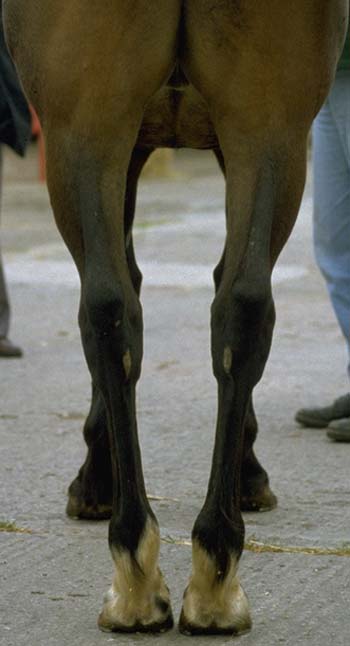Tarsus: desmitis – plantar ligament
Synonym(s): Curb
Introduction
- Historically, the term Curb has been used to describe an enlargement on the plantar aspect of the fibular tarsal bone caused by inflammation and thickening of the long plantar ligament (LPL). However, LPL desmitis is only one of several causes of curb and probably not the most common.
- Other causes of curb and differentials of LPL desmitis include:
- Peritendinous and periligamentous inflammation alone or in combination with one or more injuries of the SDFT, DDFT, or LPL.
- Superficial digital flexor tendonitis SDFT: tendinitis.
- Deep digital flexor tendonitis Deep digital flexor tendon: tendinitis.
- Mixed soft tissue injuries are common and can include any combination of above plus LPL desmitis.
- Cause: biomechanical stress due to poor conformation Musculoskeletal: conformation, intense exercise, external trauma.
- Signs: enlarged plantar surface of the fibular tarsal bone, acute - heat, pain, chronic cases more diffuse swelling and fibrosis, variable lameness.
- Diagnosis: physical examination Musculoskeletal: physical examination - adult, ultrasonography.
- Treatment: rest and controlled exercise.
- Prognosis: good if no conformational faults.
Presenting signs
- Lameness both acute and chronically progressive.
- Swelling on the plantar distal aspect of the tarsus.
Acute presentation
- Sudden onset of lameness and swelling.
Age predisposition
- Younger racehorses (2-3 years old) are more commonly affected.
Breed/Species predisposition
- Racehorses, especially Standardbreds Standardbred (pacers more than trotters) and Western performance horses.
- Not common in pleasure or sport horses.
Cost considerations
- Costs of diagnosis and treatment.
- Loss of use during treatment.
Pathogenesis
Etiology
- Race training.
- Direct trauma, including stall or wall kicking.
Predisposing factors
General
- Racing and race training, particularly in young Standardbreds Standardbred.
Specific
- Possibly poor hock conformation, such as sickle-hocked
 or tarsal valgus Musculoskeletal: angular deformity.
or tarsal valgus Musculoskeletal: angular deformity.
Pathophysiology
- Faulty conformation Musculoskeletal: conformation (sickle
 and cow hocks), poor track surfaces, poor foot conformation Musculoskeletal: conformation/poor shoeing → acute and/or chronic abnormal biomechanical stresses → cyclical fatigue of ligament.
and cow hocks), poor track surfaces, poor foot conformation Musculoskeletal: conformation/poor shoeing → acute and/or chronic abnormal biomechanical stresses → cyclical fatigue of ligament. - Direct trauma is less common.
Timecourse
- Can present acutely or chronically.
Diagnosis
Subscribe To View
This article is available to subscribers.
Try a free trial today or contact us for more information.
Treatment
Subscribe To View
This article is available to subscribers.
Try a free trial today or contact us for more information.
Prevention
Subscribe To View
This article is available to subscribers.
Try a free trial today or contact us for more information.
Outcomes
Subscribe To View
This article is available to subscribers.
Try a free trial today or contact us for more information.
Further Reading
Publications
Refereed papers
- Recent references from PubMed and VetMedResource.
- Dyson S, Blunden A & Murray R (2017) Magnetic resonance imaging, gross post mortem, and histological findings for soft tissues of the plantar aspect of the tarsus and proximal metatarsal region in non-lame horses. Vet Radiol Ultrasound 58 (2), 216-227 PubMed.
- Lempe-Troillet A et al (2013) Magnetic resonance imaging of plantar soft tissue structures of the tarsus and proximal metatarsus in foals and adult horses. Vet Comp Orthop Traumatol 26 (3), 192-197 PubMed.
- Ross M W, Genovese R J & Reef V B (2002) A collection of plantar tarsal soft tissue injuries. Proc Am Assoc Equine Pract 48, 337 PubMed.
Other sources of information
- Ross M W & Genovese R J (2011) Curb. In: Lameness in Horses. 2nd edn. Eds: Ross M W & Dyson S J. Elsevier Saunders, USA. pp 794-798.